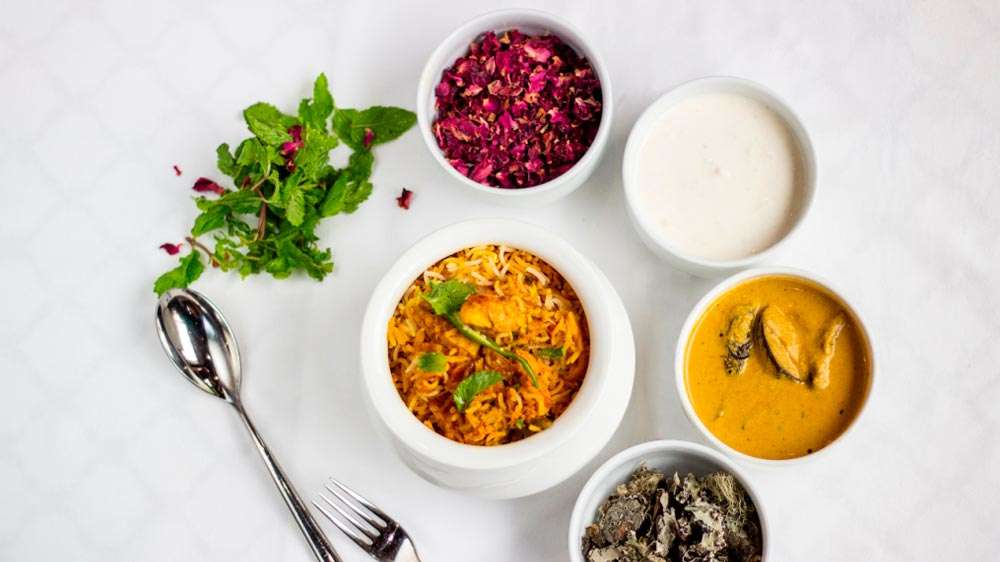THE STORY OF BIRYANI
The ‘which Biryani is better’ has been a topic of debate since time immemorial. With regional Biryani loyalists swearing by their delectable spiced rice and meat mixture, let’s dig deeper into tale of Biryanis.
The Biryani traces its origin from Middle East from where it entered India via Sindh province. This original rice and marinated meat recipe gradually travelled to various parts of the country taking regional influences.

Hyderabadi Dum Biryani-Originated in the kitchens of the Nizam, Hyderabadi Dum Biryani is closest to the original Irani recipe. The royal cooks used to marinate the meat over night with spices and then soaked the meat in yogurt before layering it with long grained Basmati rice.
Cooked in Dum (sealed Handi), the signature Hyderabadi Dum Biryani is known its spice levels, topped with fried onions and dry fruits. There is another interesting version of Biryani from Hyderabad, known as Doodh ki Biryani which is flavoured with creamy milk, roasted nuts and minimal spices. This could be a pleasant twist to the fiery Hyderabadi Biryani the world craves for.
Awadhi Biryani/Lucknawi Biryani-The award for the most good looking Biryani can be easily given to the Awadhi Biryani owing to the colours and aroma. The meat & spices is half cooked, separately from rice, flavoured with Lucknawi spices and saffron. These are layered in a deep-bottomed Handi, covered, sealed with dough and cooked to perfection. The addition of Kewra water gives it a final touch of royalty.
Kolkata Biryani-Calcutta Biryani is similar to Lucknawi Biryani owing to the fact that it came to the city with deposed Awadhi Nawab Wajid Ali Shah. However, due to the scarcity of meat, this Biryani witnessed the addition of potato along with the meat. The humble potato later became the distinguishing factor from all other Biryanis.
Thalaserry Biryani-Kerala’s Thalaserry Biryani is different from other Biryanis as instead of quintessential long grain Basmati rice; they use Jeerakasala rice, a short grained local variant. No points for guessing the fact that Kerala being the land of spices bestows this Biryani with distinct flavours of spices such as mace, peppers, fennel, cinnamon and many more. Another interesting element of this Biryani is the garnish with fried onions, cashews and raisins before it is served.
Kampuri Biryani- Biryani is one of those dishes which has travelled to every longitude and latitude of the country. When it reached Assam, it incorporated local veggies such as peas, carrots, beans, potatoes along with the chicken. Packed with colours, this Biryani is flavoured with bell peppers, cardamom and nutmeg.
Mangalorean Biryani-Mangalorean Biryani constitutes generous amount of meat .Mangalore has access to excellent fish and prawn varieties and combined in Biryani, they taste divine. There is heavy usage of green chilies, fennel and coriander. The cooking process is similar to Lucknawi Biryani where half cooked meat is layered with rice in a sealed handi and slow-cooked.
Memoni Biryani-The Memoni trading community of Sindh-Gujrat serves its own version of Biryani, derived from Pakistan Sindh Biryani. This Biryani uses less food colours compared to other Biryanis and retains the rich colours of various meats, rice, spices and vegetables. The essential components of Memoni Biryani are lamb, yogurt, fried onions, potatoes and dry fruits.
Ambur Biryani-This Biryani comes from Tamil Nadu and can be credited to the Nawabs of Arcot.It has two distinguishing features, firstly it uses a short grained Seeraga Samba rice as opposed to traditional long grain Basmati rice. Secondly, it is served with fiery brinjal curry called ennaikathirkai.
Bhatkali Biryani-No oil, no ghee this Biryani could be a health enthusiast’s guilty pleasure. Unlike the Dum Biryani, the rice is completely clean from all meaty flavours, until you start digging in, and the Masala instantly creates a delicious senstation.Originated in Bhatkal, a tinsel coastal town in Karnataka, the chicken, the spices and the rice are cooked separately, and mixed only seconds before serving.
Bohri Biryani-The distinguishing factor of this Biryani is the moistness. Cooked the dum way with charcoals over a slow-fire, the marinated meat is smoked, then layered with half-boiled rice and slow steamed in a sealed pot for two hours to trap all the aromas.
Mutanjan Biryani-A Kashmiri variant, Mutanjan Biryani is unique because of the large amount of sugar that goes in it. Akin to a Zara Pulao, this biryani is prepared with an almost equal amount of mutton, rice and sugar, blended with cream, spices, saffron, kewra water and rose water.
Tehri Biryani-And now, it’s time to answer all the memes on internet that make fun of the concept called Veg Biryani. The traditional Biryani was a meat dish, which proved to be a problem for strictly vegetarian Hindu accounts officers at the Mughal court. So the Khansamas created a new version of Biryani with lots of local vegetable and spices called Tehri which is a popular local dish in the UP belt.
While the world battles about which Biryani is better, indulge in the secret, traditional flavours of Biryani from various parts of India.
